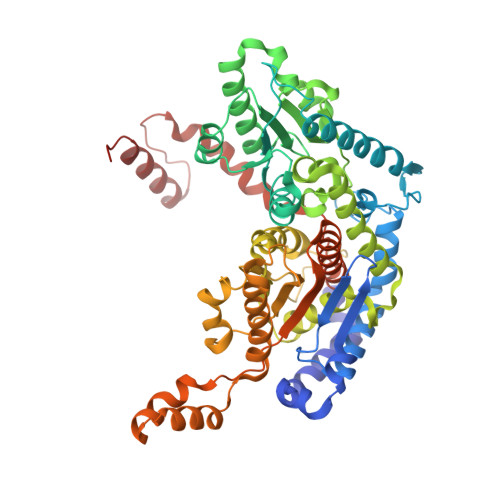Crystal structures of mouse autocrine motility factor in complex with carbohydrate phosphate inhibitors provide insight into structure-activity relationship of the inhibitors
Tanaka, N., Haga, A., Naba, N., Shiraiwa, K., Kusakabe, Y., Hashimoto, K., Funasaka, T., Nagase, H., Raz, A., Nakamura, K.T.(2006) J Mol Biology 356: 312-324
- PubMed: 16375918
- DOI: https://doi.org/10.1016/j.jmb.2005.11.076
- Primary Citation of Related Structures:
2CVP, 2CXN, 2CXO, 2CXP, 2CXQ, 2CXR, 2CXS, 2CXT, 2CXU - PubMed Abstract:
Autocrine motility factor (AMF), a tumor-secreted cytokine, stimulates cell migration in vitro and metastasis in vivo. AMF is identical to the extracellular cytokines neuroleukin and maturation factor and, interestingly, to the intracellular enzyme phosphoglucose isomerase. The cytokine activity of AMF is inhibited by carbohydrate phosphate compounds as they compete for AMF binding with the carbohydrate moiety of the AMF receptor (AMFR), which is a glycosylated seven transmembrane helix protein. Here, we report the first comprehensive high-resolution crystal structure analyses of the inhibitor-free form and the eight types of inhibitor (phosphate, erythrose 4-phosphate (E4P), arabinose 5-phosphate (A5P), sorbitol 6-phosphate (S6P), 6-phosphogluconic acid (6PGA), fructose 6-phosphate (F6P), glucose 6-phosphate (G6P), or mannose 6-phosphate (M6P)) complexes of mouse AMF (mAMF). We assayed the inhibitory activities of these inhibitors against the cytokine activity of mAMF. The inhibitory activities of the six-carbon sugars (G6P, F6P, M6P, and 6PGA) were found to be significantly higher than those of the four or five-carbon sugars (E4P or A5P). The inhibitory activities clearly depend on the length of the inhibitor molecules. A structural comparison revealed that a water-mediated hydrogen bond between one end of the inhibitor and a rigid portion of the protein surface in the shorter-chain inhibitor (E4P) complex is replaced by a direct hydrogen bond in the longer-chain inhibitor (6PGA) complex. Thus, to obtain a new compound with higher inhibitory activities against AMF, water molecules at the inhibitor binding site of AMF should be replaced by a functional group of inhibitors in order to introduce direct interactions with the protein surface. The present structure-activity relationship studies will be valuable not only for designing more effective AMF inhibitors but also for studying general protein-inhibitor interactions.
- School of Pharmaceutical Sciences, Showa University, Shinagawa-ku, Tokyo, Japan. ntanaka@pharm.showa-u.ac.jp
Organizational Affiliation:


















